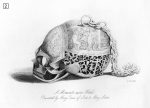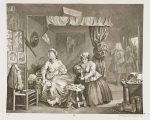Vintage
Watches in Art
Vintage
Watches in Art
These watches were baubles, toys and curiosities of the elite, which they could use to entertain friends and guests, flaunt their wealth and show off their education by understanding these new and complicated portable mechanical pieces. Consequently, they appear proudly in the centre of some portrait art from the time. This portrait by Tommaso Manzuoli, painted in around 1560 (1), is the earliest known depiction of a watch in art. The identity of the subject is unknown, however there has been speculation that the portrait is of Cosimo I de’ Medici, Duke of Florence and later the Grand Duke of Tuscany. De’ Medici was one of the most powerful men in Europe and a renowned patron of the arts who played a fundamental role in the development of the Renaissance; so he would certainly have had the wealth and interest to invest in watches. Whoever our mystery gentleman is, he appears to be a very proud watch owner.
Examples were often engraved with Latin quotations revolving around memento mori, carpe diem – remember your mortality, seize the day. As with many stories from so long ago it is impossible to know whether Mary did indeed have a skull watch, although a woman of her rank and status would almost certainly have owned watches. Still, the nature of her gruesome death in 1587, which reportedly took three strokes of the executioner’s axe, captures the imagination. The vision of Mary spending the last days of her life staring into the hollow eyes of a skull watch, ticking away the hours and reminding her of her impending execution is a poignant one.
A Portrait of Puritanism
By the early-17th century, watches had become an integral demonstration of personal style to such an extent that they would even be used to denote one’s political and religious allegiances. While we most commonly associate Puritan style with moderation, drab clothing choices and the invention of the bowl haircut, the movement still embraced the decadence of the watch. The symbolism watches held, as a wearable expression of style and status, extended to the Puritan watches of the first half of the 1600s. Far from the ornately pierced and engraved examples we see in the previous century, these watches are stripped back in design, often completely plain as an expression of the owners’ shunning of decadence whilst wearing what would have been, at the time, an expensive watch.
Philip de Koninck’s portrait of Professor Franciscus van Schooten from 1656 (3) illustrates the Dutch mathematician holding a watch of the Puritan style. Though clearly a Protestant, van Schooten’s choice to be painted presenting his watch is likely to hold more symbolism than simply his religion. The Scientific Revolution and Enlightenment created a new vision for time. Rather than a force to be feared, it was embraced as a means by which we could better understand our world. Not only was van Schooten a highly educated man with exceptional understanding of the geometry and mathematics involved in the creation of watches, but by the time this portrait was painted, one of his most famous pupils was Christiaan Huygens, the man who would go on to invent the pendulum clock.
Affordable Luxury
From the dark A Harlot’s Progress to a portrait of the charming and wealthy Miss Mary Edwards, as one of our most celebrated social commentators of the 18th century, it is unsurprising that watches and time are common subtleties in William Hogarth’s work.
Mary Edwards was among the wealthiest women in England at the time of her portrait in 1742 and one of Hogarth’s favourite patrons (5). Her choice of a gold chatelaine and watch, which can be seen hanging from the waistband of her crimson red dress, would have signified great wealth and status to anyone viewing the portrait. Sadly we have no idea who the maker of her watch was; however, with the taste of the day defining English makers as the finest in the world, we can probably assume a woman of her rank would have worn a London watch by the likes of Graham or Ellicott.
While watches in the 18th century clung on to their symbolic representation of wealth and status, their increasing presence on persons of the lower ranks signified a shift that would ultimately change the course of watchmaking history. During the second half of the century, wages of the working classes ranged from £40 a year to as little as a single figured sum. Watches, such as the one we see Miss Mary Edwards wearing, would have cost many times the average annual wage of a common worker.
The descent of the watch from high luxury to accessory can be traced through its appearance in art. As the English have never been particularly successful with making low-cost watches, it represents the start of the decline of British watchmaking, while the Swiss were quick to adjust to a more efficient and far wider cost range of mass watch production.
Eternal Love
Rossetti and Siddal’s turbulent and ultimately tragic love affair resembled in many ways the Arthurian romance and mythology that inspired him. Siddal had suffered from depression and ill health for much of their relationship and the couple had finally married after ten years’ of engagement. Siddal lost their first child, a daughter stillborn in 1860 and died as a result of a laudanum overdose whilst pregnant with their second in 1862. Beside himself with grief, Rossetti set about designing an immortal tribute to his love for all time, and what better object to symbolise time and immortality than a watch.
The faces of Sol and Luna (the sun and the moon) illustrated on the dial bear a close physical resemblance to Rossetti and Siddal. The two are separated by a winged Mercurius, leader of the dead into the underworld. Historian and antiques expert Geoffrey Munn has suggested that in alchemy, the conjunction or “marriage” of sun and moon signified a mystical unity of time and eternity. The watchcase design shows a bird in flight, which Munn identifies as an allusion to Virgil’s “Tempus Fugit Semper Amici” – time flies but love remains.
The watch dial and movement were made by Cozens, Matthews & Thorpe in London and the watchcase by Robert Gideon Macaire of Clerkenwell. In an almost fitting tribute, the story of the watch has become as great a legend as the stories that inspired its designer. The watch disappeared sometime in the mid-20th century and to this day we have no idea whether it still exists. Whether it has been destroyed, is held secretly in a private collection somewhere in the world, or has perhaps been forgotten about at the back of someone’s drawer, remains a mystery. We can only hope that the Rossetti watch is out there somewhere waiting for its very own Only Fools and Horses moment.
From A Duke To A King
Finally, this photograph (8) has been chosen to reflect the start of our journey with our mystery gentleman, possibly Cosimo I de’ Medici in 1560. By the time this photograph was taken in the 1950s, Elvis Presley was already a global superstar who could have afforded pretty much any watch he wanted, and he clearly liked his watches judging by the frequency he’s pictured wearing them. Should it be surprising, therefore, that an extremely wealthy style icon with a known love of wristwatches would choose to regularly wear more modestly priced brands like Hamilton and Elgin?
Perhaps not when we compare Elvis’s apparent affection for American watches with his persona as the wholesome and down-to-earth all American boy. With the growing presence of cinema and television being broadcast into homes around the world, the power of celebrity endorsement has become increasingly important throughout the 20th and 21st centuries. Where social emulation had previously existed between an affluent person and their social group, those people are now open to the world as bastions of style for us to aspire to at every social level.
Since its arrival nearly 500 years ago, the watch remains one of the ultimate symbols of personal style and the physical expression of time. Our watches can be expensive, cool, designer, vintage, cheap and cheerful, sports, dress, every day or for special occasions. Whatever the choice, our watch tells the person looking at us a little something about the way we want our style to be perceived and we love to share that in art. From a painting of de’ Medici to the countless wrist shots on Instagram, art provides the perfect canvas to express our love of watches.



















